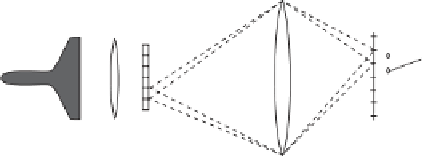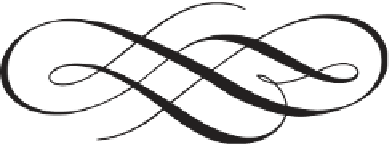Graphics Programs Reference
In-Depth Information
to generate four additional stereo images, for a total of six images that are then time-
multiplexed and sent to the display one by one.
Because of these reasons, autostereoscopic displays currently available use a differ-
ent arrangement that is illustrated in Figure 3.59. (The figure shows the main com-
ponents from above.) Light from a high-speed CRT is sent through a lens to form an
image. An array of fast LCD shutters “looks” at the image. Each shutter is a narrow
rectangle through which the entire image is sent to the Fresnel lens. At any time, only
one shutter is open, allowing the image to pass through the shutter and be focused by
the Fresnel lens in one area of the eye box.
CRT
Figure 3.59: Autostereoscopic Display With LCD Shutters.
The shutters are switched rapidly, in synchronization with the image displayed by
the CRT, so a viewer looking in two adjacent areas in the eye box sees two (time-
multiplexed) stereoscopic images.
Applications of autostereoscopic displays are currently limited by the high cost
of the hardware. There is also the fact that only one viewer can see the image at
any time, and only a limited number of views is available in the eye box. Current
applications include laparoscopic surgery and geologic displays employed in searching
for oil and gas deposits. Once costs start coming down, future applications may include
three-dimensional graphics design and game playing on personal computers.
Perspective is the rein and rudder of painting.
—Leonardo da Vinci












Search WWH ::

Custom Search